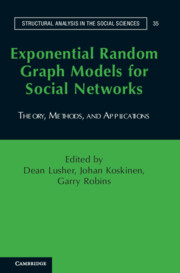Book contents
- Frontmatter
- Contents
- List of Figures
- List of Tables
- 1 Introduction
- Section I Rationale
- Section II Methods
- 6 Exponential Random Graph Model Fundamentals
- 7 Dependence Graphs and Sufficient Statistics
- 8 Social Selection, Dyadic Covariates, and Geospatial Effects
- 9 Autologistic Actor Attribute Models
- 10 Exponential Random Graph Model Extensions: Models for Multiple Networks and Bipartite Networks
- 11 Longitudinal Models
- 12 Simulation, Estimation, and Goodness of Fit
- 13 Illustrations: Simulation, Estimation, and Goodness of Fit
- Section III Applications
- Section IV Future
- References
- Index
- Name Index
12 - Simulation, Estimation, and Goodness of Fit
Published online by Cambridge University Press: 05 April 2013
- Frontmatter
- Contents
- List of Figures
- List of Tables
- 1 Introduction
- Section I Rationale
- Section II Methods
- 6 Exponential Random Graph Model Fundamentals
- 7 Dependence Graphs and Sufficient Statistics
- 8 Social Selection, Dyadic Covariates, and Geospatial Effects
- 9 Autologistic Actor Attribute Models
- 10 Exponential Random Graph Model Extensions: Models for Multiple Networks and Bipartite Networks
- 11 Longitudinal Models
- 12 Simulation, Estimation, and Goodness of Fit
- 13 Illustrations: Simulation, Estimation, and Goodness of Fit
- Section III Applications
- Section IV Future
- References
- Index
- Name Index
Summary
Exploring and Relating Model to Data in Practice
Previous chapters concentrated on the formulation and specification of exponential random graph models (ERGMs) for different types of relational data. In Chapter 6, we saw that effects represented by configurations and corresponding parameters define a distribution of graphs where the probability of getting any particular graph depends on the configurations in the graph. Chapter 7 showed that configurations are sufficient information in the sense that the probability of a graph is completely determined by statistics that are the counts of relevant configurations.
If we increase the strength of a parameter for a given configuration, graphs with more of that configuration become more likely in the resulting distribution. This simple fact is used in the three methods presented in this chapter:
Simulation: For a given model by fixing parameter values, it is possible to examine the features of graphs in the distribution through simulation to gain insight into the outcomes of the model.
Estimation: Empirically, for a given model and a given dataset, it is possible to estimate the parameter values that are most likely to have generated the observed graph, the “maximum likelihood estimates (MLEs).” Furthermore, it can be shown that the observed graph is central in the distribution of graphs determined by these estimates–but as we will see, because of the dependencies in the data, MLE requires simulation procedures.
Heuristic goodness of fit (GOF): For a fitted model (i.e., with parameters estimated from data), it is then possible to simulate the distribution of graphs to see whether other features of the data (i.e., nonfitted effects) are central or extreme in the distribution. If a graph feature is not extreme, there is no evidence to suggest that it may not have arisen from processes implicit in this model, and hence we can say that the model can explain that particular feature of the data – in other words, that such a feature is well fitted by the model.
- Type
- Chapter
- Information
- Exponential Random Graph Models for Social NetworksTheory, Methods, and Applications, pp. 141 - 166Publisher: Cambridge University PressPrint publication year: 2012
- 13
- Cited by



